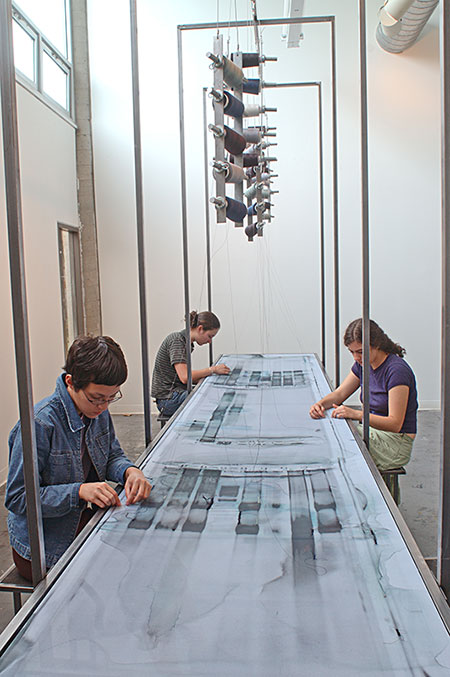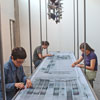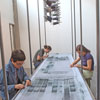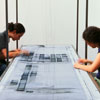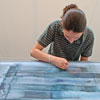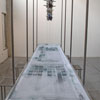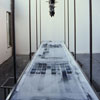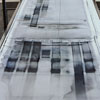Repairing RNA
Mooney Exhibition Center, College of New Rochelle, New Rochelle, New York 2005
Donald Sheehan Gallery, Whitman College, Walla Walla, Washington 2007
WORK IN EXHIBITION
REPAIRING RNA, 2004
RNA Gel of a woman and her 5-month-old fetus.
Dye sublimation print on Ultra Sheer® silk, dye, thread, steel frame and steel stools
Mooney Exhibition Center, the College of New Rochelle, New York,
10’ x 16’ x 3’
ARTIST’S STATEMENT
An RNA gel from a pregnant woman and her child is the central image of this work. This RNA test, provided by geneticist Cary Rue of OSHU, was performed to investigate the diseases the child might inherit from the mother. Repairing RNA acknowledges that, for the first time, geneticists can map individual human identity and the anomalies that make up each of our bodies. RNA, the duplicate, or mirror images of DNA, is where the evidence of anomalies can be found. Repairing the DNA of genetically inherited conditions is currently being researched and may be possible to achieve in the near future. In this work I am literally repairing the gel, duplicating the image, and fabricating the make-up of the image of the gel. I chose to randomly sew onto certain elements, thus mimicking the act of reading these gels, in which some pieces of information are more important than others.
The original photograph of the RNA* gel was a 1” x 6” digital image. I enlarged and duplicated the image onto a shear silk-like material, so it resembles the translucent film of the gels. The RNA image was reproduced using a dye sublimation printer, and then hand-dyed with watercolor. I stretched the image onto the 16’ embroidery loom to further exaggerate the reproduction of the image. The embroidery loom is inspired by similar structures used in Southeast Asia for embroidery production. Women work as a group at large tables, continually sewing, never needing to get up, because the threads are overhead. The act of sewing is both laborious and meditative. Women have engaged in this seemingly endless task for centuries. Around these tables the stories of birth, life, growth, and repair have be told throughout time. In this work I hope to address medical ethics and miracles of our day. Because of my own experiences of infant loss because of genetic conditions, I am compelled to attempt this symbolic repair. This is done by directly using the medical information on textiles and sewing into them in the manner of traditionally embellishing textiles.
*RNA is the set of proteins in our bodies that reveal genetically inherited diseases and our propensity for certain diseases. This research reveals the presence of Herpes in the mother's and child’s RNA. Herpes is the only viral disease that become hereditary or a genetic disorder.
